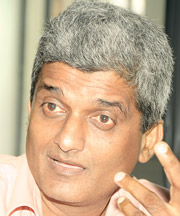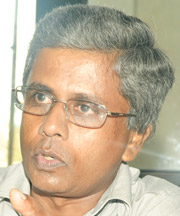|
Bolts of lightning and heavy rain claim 25 lives in
April:
Disaster Management Centre on alert to mitigate damage
By Omar RAJARATHNAM
Rains are here again and creating havoc all over the country. The
downpour is affecting most parts of the country and the bolts of
lightning are on a record high too. The Disaster Management Centre says
that Ratnapura district is one of the worst affected so far with nearly
16,606 people of 3,831 families affected and nearly 56 families have
been displaced.
Fifteen people have died due to being struck by lightning when
compared in April alone and three deaths were reported from Ratnapura
due to heavy rain, taking the death toll to 25 this month. A total of 33
people died due to lightning in 2010. Property damage has been reported
from various parts of the country.
In Colombo, many school children were stranded on the roads. There
were severe bus delays and transport was disrupted. "I am taking all
these children home now", a three wheel driver transporting six children
stranded at the university junction told the Sunday Observer.Colombo
north was once again one of the worst affected and a stranded resident
said that he was fed up of facing the same ordeal at least once every
two months. Another resident from Bloemendhal Road adjacent to the
garbage dump said that they have no other option but to take it in their
stride. "I am used to it now, I have stopped complaining", he said.
The sight is not new to the country anymore, the last downpour in
January had an adverse impact islandwide.
Director General of the Disaster Management Centre (DMC), Major
General Gamini Hettiarachchi said "The Disater Management Act No. 13 of
2005 covers all these catastrophes and we have made steady progress in
terms of improving the quality of rescue operations by increasing the
equipment in most of these flood affected areas.
 |
|
Nuwan Kumarasinghe |
 |
|
D.A. Jayasinghearachchi |
 |
|
Gamini Hettiarachichi |
The damage due to floods in January and February costs the country
thousands of millions of rupees, but we minimised the amount of
fatalities to 40 in January and 18 in February. We are working on
reducing this figure further as we improve to counter such disasters",
he said.
Q: How has the DMC prepared to counter such disasters and
organise rescue and relief operations?
A: We have purchased over 50 catamarans to use during such
disasters and they are to be distributed to the divisional secretariats
of some of the most vulnerable regions. This is to ensure that rescue
operations does not come to a halt due to lack of resources.
The Treasury has also granted us Rs. 50 million for flood mitigation
projects and we have also improved the communication system between
organisations such as the Irrigation Department and the Meteorology
Department so we have their undivided assistance when devising our
rescue operations.
The Disaster Relief Centre, another wing of the Ministry of Disaster
Management also works closely with us to identify the immediate basic
needs of displaced families. Further.
Our 24 hour Emergency Operations Centre constantly monitors the
situation so we do not miss out on being available to rescue the
affected victims.
A public communication scheme has been tied up with a leading mobile
telecommunications service provider where in case people need to be
advised to re-locate within a short timespan, we will send out text
messages with the DMC identification on it, so the public are kept in
the loop too.
Q: Was the damage of the January and February floods so high
because the DMC didn't have these plans in place by then?
A: We have improved the system after learning from those
incidents. Having said that, the rainfall is increasing by tremendous
margins when compared to corresponding years where in places like
Anuradhapura the rainfall recorded hit 285.3 mm whilst their 30 year
average stands at 55.4 mm, needless to say this is a huge increase to
cope with. Batticaloa recorded a staggering 1195.5 mm in January alone
and 465.8 mm in February. When such unusual figures are recorded, it
makes it difficult for any organisation to combat.
Q: Lightning is clearly becoming a issue to watch out for as
well, is the DMC involved in trying to mitigate the damages in this area
too?
A: We have experienced a sharp increase in the number of
lightning related deaths, I think people need to be told on how they can
protect themselves from lightning.
We have taken it into account, but the Meteorology Department will be
able to shed more light on it.
We contacted Meteorologist in-charge, The National Meteorology
Department, D.A. Jayasinghearachchi said that lightning is becoming a
threat since late. "It is normal that we have powerful bolts of
lightning during the Inter-Monsoon season of March/April and the
October/November, but the number of deaths have increased this year", he
said We were also joined by the Electronics Engineer of The National
Meteorology Department, Nuwan Kumarasinghe.
Q: What are the misconceptions the people have about lightning
and what should they avoid doing to protect themselves from being struck
by a bolt?
A: Having a shower even in the most compact bathrooms can be
dangerous during times of lightning, the conductivity of water is so
high that if lightning strikes a plastic water pipe at a height, the
effects can get into the water and cause damage to the person having a
bath. Many misconstrue that as long as plastic objects cover the
conductor, it's safe but it is not so. Being in open land areas should
be avoided at all costs. If you are in a closed vehicle, there is no
risk, but open vehicles such as Motorbikes, bicycles and even vehicles
with open hoods can attract lightning.
All electrical appliances must be switched off at all times and the
antenna wires must be disconnected from the television socket and left
facing outside so even if the antenna is struck by lightning the effect
is release outside the house.
The use of land phones is one of the most dangerous practices during
lightning. Telephone wires are located at a height and if it's struck by
lightning, it can travel through them and affect your phone and then
your ear if you are using it. That must be disconnected too.
Q: How about the use of laptops, when they are fully charged
they are not connected to any electric wire, is it safe to use them
indoors?
A: No, laptops have many metal components and they are as good
as working electrical appliances where lightning is concerned. Whether
it is connected to an electric connection is immaterial because the
lightning has enough voltage to attract its metal components.
Q: How does a lightning conductor help mitigate the risk of a
lightning attack?
A: The conventional lightning conductor can be incorporated
into a construction plan and used as a preventive structure to attract
the effect if the bolts and then transfer them through defines routes to
the earth.
They cost approximately Rs. 8,000 and reduce damage due to lightning.
Apart from human damage, nearly Rs 300 million worth damages are
inflicted on property annually and also loss of animals. When lightning
damages factory property, the down time needs to be regarded as direct
damages caused by the lightning too.
We ensure that people are made aware about preventive measures at
least twice a year during inter-monsoon seasons but it is often
forgotten and the price we pay is a human life.
It is our responsibility to ensure that we make sure we do not
disregard the fatal effects lightning can cause and that with vigilance
and proper care, they can be avoided to a great extent.
|

